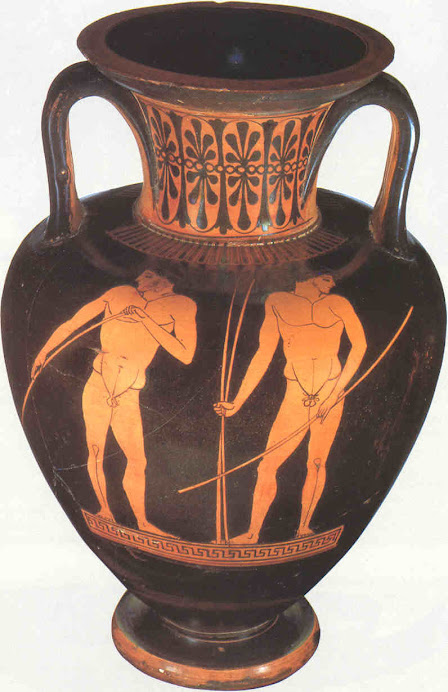Kynodesme
The ancient Greeks and Romans were not prudish about nudity, as evidenced by all those naked statues, such as this statue of the god Apollo from the Temple of Apollo in Pompeii, 1st cent. BC to 1st cent. AD.
But you may have noticed that the penises of those statues are always rather small. Why? Because the Greeks, and later the Romans, considered a large penis to be vulgar-looking. Also, if the glans (head) of the penis was showing, it was considered vulgar. So, the ideal penis looked like this close-up of the statue of Apollo: small, with the glans completely covered by the foreskin.
Of course, the Greeks were perfectly aware that the penis becomes larger and the glans becomes uncovered when the penis is erect, as shown on this statue of a lusty satyr from 540-530 BC. But that may be exactly why a large penis and uncovered glans were considered vulgar and perhaps somewhat obscene, because it suggested at least a partial erection. A small penis with the foreskin covering the glans was safely not erect, and therefore not obscene.
Greek athletes competed nude, and some actors appeared on stage nude. This was not considered improper at all, but if the glans of the athlete's or actor's penis could be seen, which might well happen to an athlete whose penis was swinging around during competition, it was considered improper. The solution: the kynodesme.
The word kynodesme means "dog leash" in Greek, which tells me that the Greeks had a sense of humor about this fashion accessory. It was a thin leather strap that was tied around the tip of the foreskin, so the glans could not emerge and be seen. In the painting above, which dates to 480 BC, the kynodesme is tied with a bow.
On this amphora, dating to c. 500 BC, the athlete on the right also has a kynodesme that's tied with a bow.
This painting from 520-510 BC shows an athlete putting on a kynodesme. He's stretching out the tip of his foreskin, and in his other hand is the leather strap that will be tied around it.
In this statue, called the Boxer of Quirinal, c. 100-50 BC, the leather strap itself is not visible in the sculpture, but the way his penis is pulled up and the end of it is constricted is evidence that he is wearing a kynodesme.
It may be hard to see from those paintings and statues exactly how the kynodesme works. So I am delighted to present photos that John from England, who follows my blog, sent me of a modern kynodesme that he made for himself. His kynodesme is made from shoelaces, not leather, but it works exactly the same way. It's tied around the tip of his foreskin, keeping the glans safely inside.
Here's a side view.
And then the kynodesme goes around his waist to hold it in place, something that was also done in ancient times but is not very visible in the ancient paintings and statues. This pulls up his penis, just like the Boxer of Quirinal.
We close with a rear view of John's kynodesme – and a rear view of John.
Many thanks, John, for this great demonstration of an ancient accoutrement.











13 comments:
very interesting. I knew that having or showing a big (and therefore excited) dick was inappropriate, but because it was disharmonious. Not for moral or modesty reasons. This in ancient Greece.
Always interesting to learn about the ancients. I knew about them, but now I know what the lace was called.
Thanks to John from England. John, do you have a blog or twitter account of your nude photos?
What an interesting post! I always enjoy these educational ones.
Very interesting! Out of curiosity, some indigenous tribes in Brazil, mainly in the Amazon region, use the same method of tying the foreskin, whether to prevent involuntary erections or to protect the penis during a run.
Anonymous - I've migrated my nude content over a few sites in recent years. At the moment I'm gradually uploading them on mewe. You might have to have an account to see them, I'm not sure:
https://mewe.com/johnwnaturist.45/posts
It's also used in North America during an inipi (sweat lodge). It was thought direct exposure of the glans to steam impaired one's ability to have children, so tie it up to temporarily impair erections.
Learning a lot today. Fascinating post. Sometimes a little uncomfortable seeing things tied up but that’s just how it was and is. Much better understanding of old statues.
Isn't it odd that big cocks and bare cockheads were vulger? Yet I have seen Geek pottery the show males fucking. F the thought hard-ons so crude, why show males fucking?
Thank you John from England. Nice.
I had already read in several transcriptions that the representation of a small sex was a sign of diplomacy. However, I've just learned this new word: "kynodesme".
Thanks for this well-done article. (ツ)
I have learned something new about the kynodesme, however, how did it prevent erections? I can see how it would prevent normal exposure of the glans and thus impropriety, however an erection is quite a powerful force that I would have thought would eventually force it over the foreskin.
Knowing how men can get erections in the most unlikely situations, was it considered unseemly for men in ancient Greece to not have erections under control at all times?
Perhaps the kynodesme is intended to be painful and the pain used to suppress erections.
Anal was also considered vulgar. The proper way was with both partners standing face to face, the younger one (eromenos) leaning against a wall, and the older one (erastes) thrusting his penis between the younger one's thighs.
"Gay" is actually relatively novel. Historically most male eros has been either pederasty like the Greeks, or third genders, or teenagers just experimenting but growing up to marry women.
Post a Comment